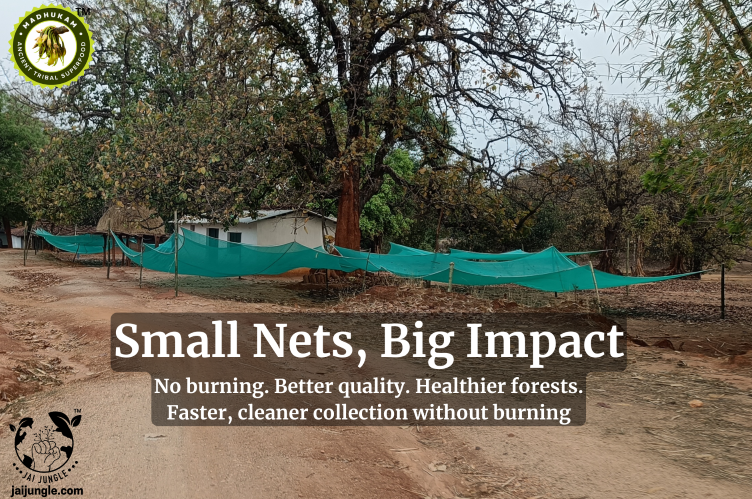When collection practices ignite the forest
Across Central India, the Mahua season arrives with dry winds, leaf-fall, and urgent activity on the forest floor. In many landscapes, a long-standing practice persists: burning the ground beneath Mahua trees to clear leaf litter for faster collection. While intended as a controlled burn, this practice often collides with dry fuel loads and wind, and escapes into the surrounding patch, burning more than intended. The results are familiar to forest managers and communities alike: scorched understories, smoke haze, damaged micro-habitats, and a season of additional patrolling and firefighting.
Fire weather in much of India’s dry forests aligns with a long season that spans November to June, with the most intense activity typically occurring in April–May—when soils are driest and fuels are cured (Forest Survey of India, ISFR fire monitoring; MoEFCC’s National Action Plan on Forest Fire, 2018). Most ignitions are human-caused—including ground-clearing burns that, in Mahua landscapes, are tied to the collection window itself. In especially hot, dry Aprils and Mays, wind and accumulated litter sharply raise the odds that a “small” ground-cleaning fire becomes a runaway incident, with damaging ecological and administrative consequences.
This article documents a practical, field-tested alternative already used at small scale: scientific collection nets for Mahua flower gathering. A single change in collection practice removes the incentive to burn, improves efficiency, safety, and flower quality, and simultaneously reduces forest-fire risk. The discussion draws on grounded experience from Kendpani and Jamtoli (Jashpur District), where the Mahua season peaks in April–May, and is written for forest professionals, community leaders, and CSR planners seeking low-cost, high-impact prevention strategies.
1. Why ground burns persist during Mahua season
Practical intent, risky outcome. Collectors value a clean forest floor to speed up gathering the fresh fall and reduce contamination with unrelated litter. In the absence of alternatives, lighting a quick fire under the canopy looks like the simplest way to remove leaves and twigs. But as the season advances and dry biomass increases, the margin of error shrinks.
“Controlled” seldom stays controlled. Even experienced hands can underestimate gusty winds, fuel continuity (cured grasses and shrubs), slope effects, and afternoon heat. Fire spreads with the wind, runs upslope faster, and can turn patches into a mosaic of burned ground within minutes. In the tight labour window of collection, there is rarely a crew equipped for containment lines, back-burns, or mop-up, so escape is common.
Local realities that escalate risk. Intentional lighting for ground-clearing remains the most common ignition; matches/bidis and incidental spread from nearby cooking fires add to the tally. Escalation factors include wind, high leaf-litter loads, continuous cured fuels, and terrain. In many places, enforcement is sporadic, leaving practice unchanged.
2. The five costs of burn-based collection
Biodiversity loss. Dry forest ecosystems host ground-nesting birds, reptiles, amphibians, pollinators, and detritivores. Repeated burns strip cover, destroy nests and micro-habitats, and can depress local diversity. Night-flying pollinators that visit Mahua are affected indirectly when understorey structure and nectar sources decline across the patch.
Soil and hydrology degradation. High-intensity or repeated burns volatilise nutrients, reduce soil organic matter, increase bulk density, and can form water-repellent layers that reduce infiltration—leading to more runoff, erosion, and weak moisture storage in the following monsoon. Over years, this undermines soil formation and carbon storage. Even low-intensity burns, done frequently, erode soil biological activity.
Human health and safety. Smoke exposure during collection, eye and respiratory irritation, and the accident risk of escaping fires are recurrent concerns—for communities and forest staff—often precisely when temperatures peak.
Mahua quality and losses. Burned floors and ashy surroundings increase contamination, raise cleaning effort, risk moisture mismanagement later in drying, and can reduce overall quality—creating avoidable wastage and value loss.
Administrative workload and opportunity cost. A mosaic of escaped burns prolongs the fire season, demands more suppression tasks, and diverts staff time from silviculture, soil–water conservation, and community work to emergency response. National policy repeatedly stresses that prevention beats suppression.
3. The small intervention that changes behaviour
Scientific collection nets—simple, durable nets spread under Mahua canopies—remove the reason to burn. Flowers fall cleanly into the net, staying off the ash-and-soil interface, and can be gathered quickly without raking the entire forest floor. In Jashpur experience, nets are reusable and, with basic care, last multiple seasons (about 4–7 years).
This is not a technological leap; it is a behavioural pivot. By providing a practical alternative to ground clearing, nets align the collector’s goals (speed, cleanliness, reduced drudgery, better quality) with forest goals (no ignition, no escape, intact understorey). Where nets are used, the incentive to light a fire vanishes.
4. Evidence from Kendpani and Jamtoli (Jashpur)
Adoption trajectory. In 2022, roughly 20 collectors tried nets on around 20 trees. By 2025, nets were in use on 300+ trees. The spread has been neighbour-to-neighbour, with encouragement from the local FPC and district administration, but without complex formalities.
Fire incidence. In net-covered areas of Kendpani, no forest fires have been reported since 2022. The causal chain is straightforward: when the ground is not burned for clearing, there is no ignition source under those canopies.
Labour and consistency. Collectors report substantial effort savings during the 25–30 day window: less raking, less bending, quicker gathering. Because the work is lighter, households manage more trees and collect more consistently across the season. Several report roughly 20% higher collection due to cleaner fall and faster gathering.
Quality. Keeping flowers off the soil surface reduces contamination and cleaning time; colour and aroma are better preserved. Subtle smoke taint and ash—common around burned patches—are avoided.
“I personally own more than ten Mahua trees. Earlier, even with a large family, we could not finish picking from five or six trees. Now, with nets, I manage more than 25 trees alone.” — Karnpal Singh, Mahua farmer/collector (Kendpani)
5. Why it matters for forest management
Removes a major ignition source. Burn-based clearing is a primary driver of early-season ignitions in Mahua patches. Replace it, and fire incidence falls—not because of stricter enforcement, but because collectors no longer benefit from lighting fires.
Converts collectors into stewards. Once nets are in place, households discourage burning nearby to protect their own trees and equipment. Community norms shift from tacit acceptance of ground burns to active prevention, supported by peer pressure rather than penalties.
Restores the living forest floor. No burns mean litter remains, feeding detritivores and soil microbes, improving infiltration ahead of the monsoon, and maintaining micro-habitats for ground-dwelling fauna. The patch becomes quieter and richer, season by season.
Reduces suppression workload. Fewer ignitions translate into fewer smoke days, less emergency response, and more time for positive forestry—silvicultural operations, soil–water works, enrichment planting, and community engagement.
Supports climate resilience. By helping soils retain organic matter and moisture and by maintaining understorey diversity, nets contribute to resilience under hotter, drier pre-monsoon conditions.
6. A brief science explainer: soils, water, and biodiversity
Litter as infrastructure. Leaf litter is a living blanket. It shades the soil, cushions raindrop impact, and slowly releases nutrients as it decomposes. Fire strips this protective layer and resets the soil food web.
Infiltration vs. runoff. Unburned litter and a porous topsoil allow rain to soak in. Repeated burns can create hydrophobic (water-repellent) layers, pushing rain into runoff and erosion. Fire-free seasons help soils drink again.
Organic matter and fertility. Organic matter holds water and nutrients and forms the aggregates that keep soil open and breathable. Frequent burning reduces organic matter, weakens structure, and dulls microbial activity. Avoiding burns lets dark, spongy topsoil rebuild.
Ground-level life. The first 30 centimetres above the ground host nests, refuges, and foraging paths for a web of organisms. Burns erase this architecture. Skipping burns gives ground-nesting birds, reptiles, amphibians, and pollinators a chance to persist and recover.
These mechanisms are consistent with widely reported findings from Indian dry-forest literature and national guidance emphasising prevention over suppression.
7. Addressing common concerns (informative, not procedural)
Will nets work under large, irregular crowns?
Yes. Nets are adaptable tools, positioned where fall is densest. Collectors already know the high-fall zones around each tree.
Do nets increase pilferage or conflict?
Local experience suggests the opposite. As benefits become visible, neighbours respect nets and avoid burning nearby. Social norms shift quickly when a tool helps everyone.
What about wildlife and litter?
Nets are seasonal and attended; they are spread for collection and removed after use. In many villages, nets are issued before the season and collected back after for washing and secure storage—minimising off-season litter and protecting wildlife and soils.
Does this really reduce fires?
In Kendpani, no fires have been reported since 2022 in net-covered areas. Mechanistically, removing the ground-clearing ignition point removes the fire.
8. Livelihoods and dignity, not just prevention
While the central claim is fire prevention, the co-benefits matter:
- Cleaner, higher-quality Mahua, with less ash or grit.
- Lower drudgery and more consistent collection through the season.
- Expanded tree coverage per household as effort falls.
- A sense of ownership and pride in fire-free collection—people are not just extracting a product; they are caring for a living patch that supports their future seasons.
These are not add-ons; they are reasons the intervention sticks without constant policing.
9. System signals worth watching
Because the approach is small, cheap, and behaviour-based, early signals are simple and compelling:
- Ignition reduction around netted trees during April–May.
- Smoke-day decline across known hotspots.
- Collector testimonials citing cleaner produce and lower effort.
- Neighbour spillovers, where non-users stop burning near netted trees.
These are the kinds of signals that persuade departments and donors—not through grand targets, but through quiet, observable change.
A small tool with large consequences
Mahua livelihoods need not sit on a tinderbox. A small intervention—scientific collection nets—replaces fire with cleanliness, drudgery with efficiency, and conflict with stewardship. It improves collection quality and income potential, and at the same time addresses core forest-management challenges: ignition control, soil and biodiversity protection, and staff workload during the hardest months.
Kendpani and Jamtoli show that behavioural solutions can reshape outcomes. If the aim is to reduce fire incidence in Mahua-rich patches, protect biodiversity and soils, and support rural livelihoods, the most elegant answer may also be the simplest: stop lighting the ground and catch the flowers where they fall. With each net spread beneath a canopy, a small piece of forest becomes quieter, cleaner, and safer—for people, for the living soil, and for the seasons yet to come.
Ref.
Forest Survey of India (FSI). India State of Forest Report 2021 – Chapter 5: Forest Fire Monitoring. Dehradun: FSI. OpenCity
MoEFCC. National Action Plan on Forest Fire (NAPFF), 2018. Government of India—Parliament reply confirming NAPFF and its implementation. Digital Sansad
Agbeshie, A. A., Abugre, S., Atta-Darkwa, T., & Awuah, R. (2022). A review of the effects of forest fire on soil properties. Journal of Forestry Research, 33, 1419–1441. SpringerLink
Certini, G. (2005). Effects of fire on properties of forest soils. Oecologia, 143(1), 1–10. PubMed
Schmerbeck, J., Kohli, A., & Seeland, K. (2015). Wildfires, ecosystem services, and biodiversity in tropical dry forest in India. Review/working paper with Indian case insights. opus.bibliothek.uni-augsburg.de
Sagar, N., et al. (2024). Forest fire dynamics in India (2005–2022). Ecological/seasonality analysis highlighting April–May peaks. ScienceDirect
Certini, G. (reviewed in) Agbeshie et al. and Certini (2005) — supporting notes on hydrophobicity/infiltration changes; see also hydrology-focused review: Wildfire Induces Changes in Receiving Waters: A Review with Implications for Re/Forestation (open-access synthesis). PMC
Context on human-caused ignitions in Mahua landscapes: Forest fires raze parts of India amid heat, dry weather (news report referencing Mahua-collection burns in Odisha, 2024). Reuters

